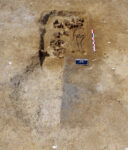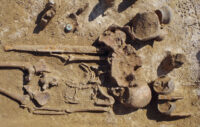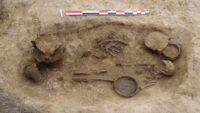 An excavation in the village of Mercin-et-Vaux, northern France, has unearthed a Gallic necropolis scarred by shells and trench-digging activities during World War I. Archaeologists discovered 11 graves containing human remains dating to between the late 5th and 4th centuries B.C. Two of them are enclosure graves, one surrounded by a circular enclosure, the other by a square enclosure. Both of the enclosure graves were damaged. The circular enclosure was disturbed on its east end by shell impacts. The north wall of the quadrangle was cut into when a trench was dug, tearing up the skull and the left side of the body.
An excavation in the village of Mercin-et-Vaux, northern France, has unearthed a Gallic necropolis scarred by shells and trench-digging activities during World War I. Archaeologists discovered 11 graves containing human remains dating to between the late 5th and 4th centuries B.C. Two of them are enclosure graves, one surrounded by a circular enclosure, the other by a square enclosure. Both of the enclosure graves were damaged. The circular enclosure was disturbed on its east end by shell impacts. The north wall of the quadrangle was cut into when a trench was dug, tearing up the skull and the left side of the body.
 All but one of the burials are inhumation graves. They are orientated east to west and are loosely grouped in sets of two to four tombs. Six of the burials are nearer the edge of the excavated area, suggesting there is more of this necropolis still to be found. A 12th pit was found containing a few ceramic vessels and two fibulae aligned as they would have been if worn. There was no surviving skeleton and no evidence of cremation. The silty soil is a poor preserver of bones, so archaeologists believe it too was a grave but the remains disintegrated.
All but one of the burials are inhumation graves. They are orientated east to west and are loosely grouped in sets of two to four tombs. Six of the burials are nearer the edge of the excavated area, suggesting there is more of this necropolis still to be found. A 12th pit was found containing a few ceramic vessels and two fibulae aligned as they would have been if worn. There was no surviving skeleton and no evidence of cremation. The silty soil is a poor preserver of bones, so archaeologists believe it too was a grave but the remains disintegrated.
 Of the ten inhumed individuals, nine are adults — three women, six men — and one is a child about seven to nine years of age whose grave goods suggest she was female. The deceased were interred in supine position. Above their heads and at their feet are numerous ceramic containers and food offerings. Meat from pigs, sheep or goats and beef were found in the graves.
Of the ten inhumed individuals, nine are adults — three women, six men — and one is a child about seven to nine years of age whose grave goods suggest she was female. The deceased were interred in supine position. Above their heads and at their feet are numerous ceramic containers and food offerings. Meat from pigs, sheep or goats and beef were found in the graves.
Three of the men’s graves are furnished with swords; one of them also has a dagger and a spear. The women’s grave’s contain jewelry (bracelets, fibulae) and utilitarian objects like a terracotta spindle whorl and an iron razor. The little girl has the richest adornment: a small torque around her neck and a bangle bracelet on her wrist.
The comparatively high proportion of men’s burials, armed ones at that, in this area may be evidence the deceased were roughly concentrated by sex and/or status within the wider necropolis.